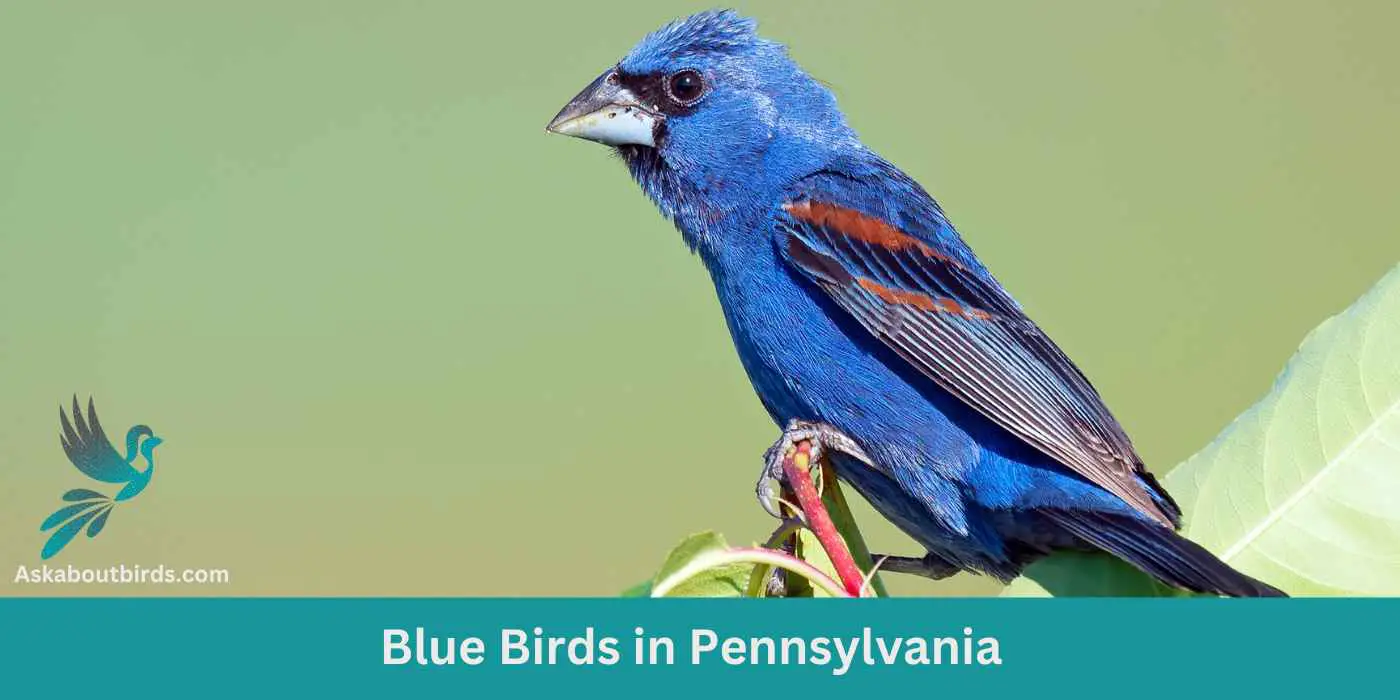Pennsylvania, with its diverse habitats ranging from dense forests to open farmlands, is a haven for bird enthusiasts. This guide is specially curated for those who are particularly intrigued by the various species of blue birds found in the state.
It not only provides a comprehensive list of blue birds you can encounter in Pennsylvania but also includes a free photo guide to help you identify and appreciate the beauty of these avian wonders. Let’s embark on this exciting journey to explore the world of blue birds in Pennsylvania!
Blue Birds Found In Pennsylvania
The diverse range of habitats in Pennsylvania, from the Appalachian Mountains and dense hardwood forests to rivers and wetlands, makes it a rich environment for a variety of bird species. The state’s location along the Atlantic Flyway also makes it a crucial stopover point for migratory birds. The varied elevation, from sea level to mountainous regions, provides different niches that cater to the needs of various bird species, thereby contributing to the diversity of birds found in the state. This includes an array of blue birds, which are particularly fascinating for bird watchers and nature enthusiasts alike.
Eastern Bluebird
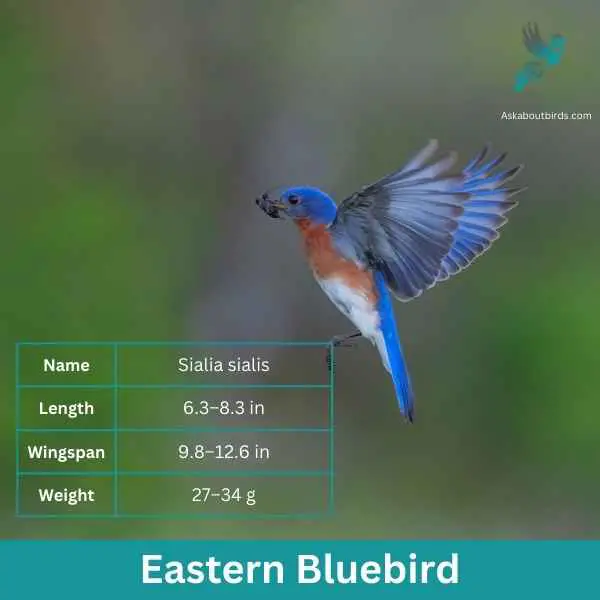
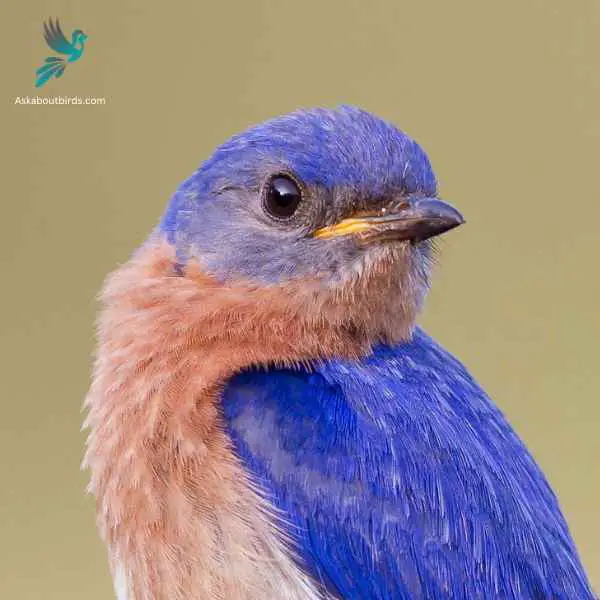
| Feature | Measurement |
|---|---|
| Scientific Name | Sialia sialis |
| Length | 6.3–8.3 in |
| Wingspan | 9.8–12.6 in |
| Weight | 27–34 g |
The Eastern Bluebird (Sialia sialis) is a small thrush found in open woodlands, farmlands, and orchards, and is recognized for its vibrant blue and red coloration. Male Eastern Bluebirds are dazzling with bright blue upperparts and a rusty or brick-red throat and breast, while females, though less colorful, still offer a similar pattern. The bird is native to North America and is commonly seen east of the Rockies, from Canada to the Gulf States and southeastern Arizona to Nicaragua.
Eastern Bluebirds feed on insects, wild fruit and berries. They have a gentle nature and are often seen perched alone or in small groups in the open, scanning the ground for prey. They are cavity nesters and will use old woodpecker holes or birdhouses if they are the right size.
Indigo Bunting


| Feature | Measurement |
|---|---|
| Scientific Name | Passerina cyanea |
| Length | 4.5–5.1 in |
| Wingspan | 7.1–9.1 in |
| Weight | 11.2–21.4 g |
The Indigo Bunting is a strikingly vibrant songbird, often hailed for its brilliant blue plumage and melodic song that graces woodlands and meadows during the warmer months.
Appearance: Males are renowned for their bright indigo blue feathers, which can appear darker in certain lights. Females and juveniles, on the other hand, are brown with subtle hints of blue on their wings and tail. The species lacks the vibrant streaking or spotting commonly found in many other songbirds.
Diet: Indigo Buntings primarily subsist on seeds, especially during non-breeding seasons. During the breeding season, they also consume a variety of insects such as beetles, caterpillars, and spiders, providing essential protein for their growing chicks.
Reproduction: Indigo Buntings build their nests close to the ground in shrubs or low tree branches. These nests, crafted meticulously with grasses and other plant materials, cradle clutches of typically 3 to 4 eggs. After hatching, the young are fed by both parents until they’re ready to fledge.
Blue Jay

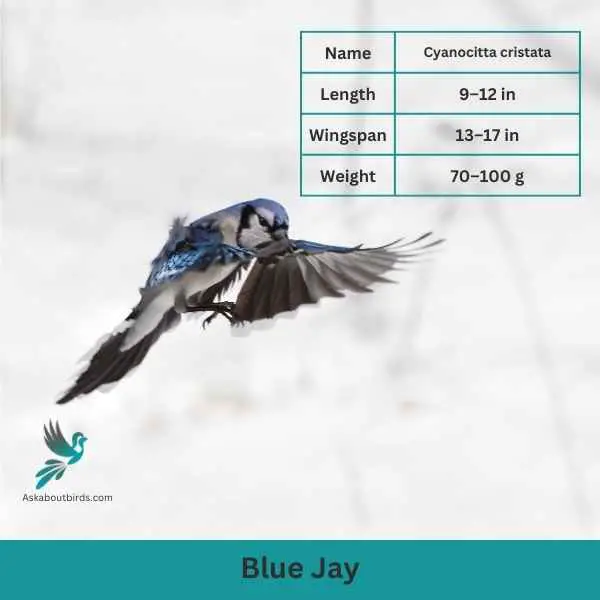
| Feature | Measurement |
|---|---|
| Scientific Name | Cyanocitta cristata |
| Length | 9–12 in |
| Wingspan | 13–17 in |
| Weight | 70–100 g |
The Blue Jay is a vibrant and easily recognized bird, known for its intelligence, distinctive calls, and bold behavior, commonly found throughout the eastern and central United States.
Appearance: The Blue Jay sports a striking blue upper body with white and black markings. Its face has a pronounced white patch with a black necklace that runs across the throat and around the head. The bird also features a pronounced blue crest, which can be raised or lowered, and its wings and tail are brightly colored with black bars and white tips.
Diet: Blue Jays are omnivores. Their diet consists primarily of seeds, nuts, especially acorns, fruits, and small insects. They’ve also been known to eat eggs or nestlings of other birds occasionally. Blue Jays often store food items in caches to eat later.
Reproduction: Blue Jays are monogamous birds that form long-lasting pair bonds. They typically build their nests in trees or large shrubs, constructing them from twigs, grass, and sometimes using mud as a binder. The female lays a clutch of 3 to 6 eggs, which are pale blue or sometimes white with brown speckles.
Blue Grosbeak
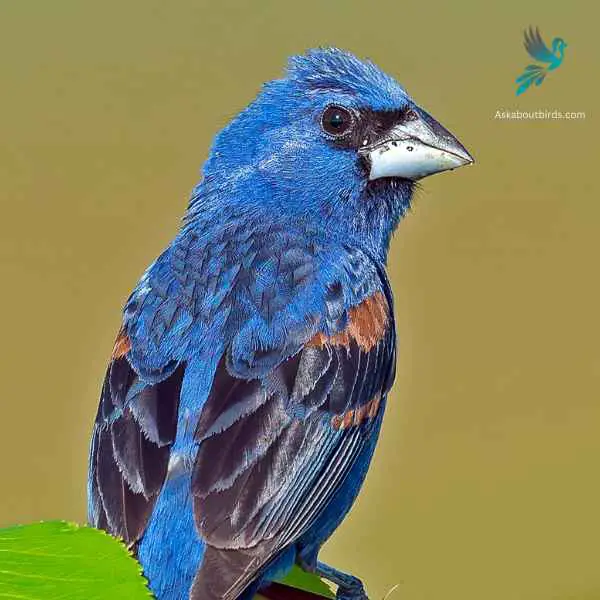

| Feature | Measurement |
|---|---|
| Scientific Name | Passerina caerulea |
| Length | 5.5 to 7.5 in |
| Wingspan | 10 to 11 in |
| Weight | 26 to 31.5 g |
The Blue Grosbeak is a medium-sized songbird found in North and Central America. The male Blue Grosbeak displays stunning plumage with deep blue feathers on its body and head, while the female has more subdued brownish tones. Both sexes have a thick, conical bill, which gives them their name “grosbeak,” meaning large beak.
These birds prefer open habitats such as grasslands, brushy areas, and woodland edges. Blue Grosbeaks are known for their melodious songs, which consist of a series of rich and varied notes. They primarily feed on seeds and insects, using their strong beaks to crack open seeds and forage on the ground or in low vegetation.
Tree Swallow
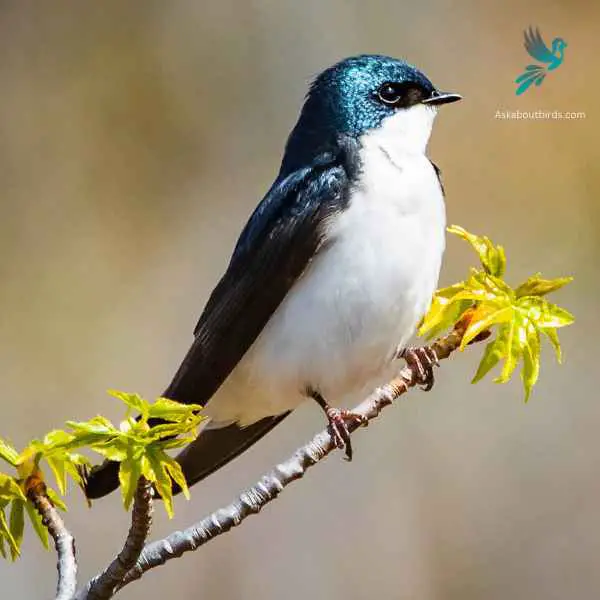
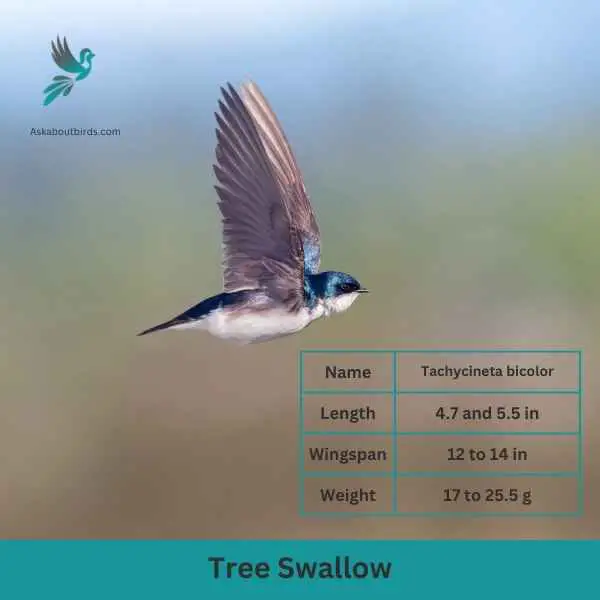
| Feature | Measurement |
|---|---|
| Scientific Name | Tachycineta bicolor |
| Length | 4.7 and 5.5 in |
| Wingspan | 12 to 14 in |
| Weight | 17 to 25.5 g |
The Tree Swallow is a graceful and agile bird, best recognized for its iridescent blue-green upperparts and sweeping flight patterns over open fields and water.
Appearance: The Tree Swallow is sleek with a streamlined body. The upperparts shine with a blue-green iridescence while the underparts are white. They possess long, pointed wings and a slightly forked tail, aiding in their agile flight.
Diet: Tree Swallows primarily feed on flying insects, skillfully catching them mid-air. During colder months when insects are scarce, they can switch to a diet of berries, particularly those of the bayberry, which other birds might find hard to digest.
Reproduction: Tree Swallows are cavity-nesters, typically choosing natural holes in trees or using bird boxes. They line their nests with feathers, creating a soft environment for the eggs. The female will lay a clutch of 4 to 7 white eggs.
Barn Swallow


| Feature | Measurement |
|---|---|
| Scientific Name | Hirundo rustica |
| Length | 6.5–7.5 in |
| Wingspan | 12.5–13.5 in |
| Weight | 16–22 g |
The Barn Swallow is a sleek, agile bird renowned for its graceful flight patterns and iconic forked tail, often seen darting over fields and water bodies in search of flying insects.
Appearance: Barn Swallows have deep blue, almost iridescent, upperparts and a rufous to tawny underbelly. Their distinctively forked tail and long wings give them a streamlined look. Both males and females have a similar appearance, though males often exhibit slightly brighter colors and a deeper fork in the tail.
Diet: Barn Swallows feed primarily on flying insects, which they catch in mid-air during their agile and acrobatic flights. Their diet includes flies, beetles, moths, and other small flying insects.
Reproduction: Barn Swallows are known for building their mud nests on man-made structures, particularly barns, bridges, and eaves. The nest is cup-shaped and made from mud pellets, often lined with feathers. The female lays a clutch of 4 to 6 eggs.
Purple Martin
Scientific Name: Progne subis
Length: 7.5-9.1 in (19-23 cm)
Wingspan: 15.3-16.1 in (39-41 cm)
Weight: 1.9-2.3 oz (55-65 g)
The Purple Martin is a popular and widely recognized bird species, known for its acrobatic flight and social behavior.
Appearance: Purple Martins have a dark, glossy purple-blue plumage. Males are almost entirely dark purple while females and young birds have a lighter, greyish belly and throat.
Diet: The diet of Purple Martins primarily consists of flying insects such as beetles, flies, dragonflies, and moths. They catch their prey in mid-air while flying.
Reproduction: Purple Martins nest in colonies, often using artificial nest boxes provided by humans. The female typically lays a clutch of 4 to 6 white eggs, and both parents participate in incubating the eggs and feeding the chicks.
Belted Kingfisher

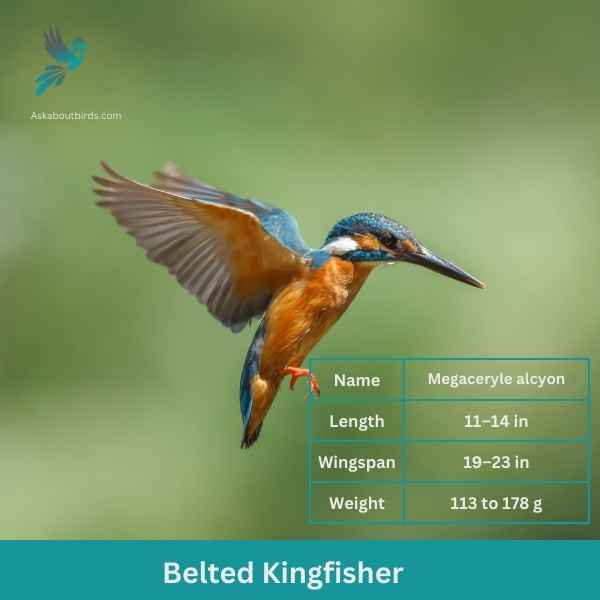
| Feature | Measurement |
|---|---|
| Scientific Name | Megaceryle alcyon |
| Length | 11–14 in |
| Wingspan | 19–23 in |
| Weight | 113 to 178 g |
The Belted Kingfisher is a distinctive and easily recognizable bird, frequently observed near water bodies, where it can be seen diving headfirst to catch prey.
Appearance: Sporting a prominent crest, the Belted Kingfisher has a slate blue-gray upper body and white underparts. Males possess a single blue band across their white chests, while females have an additional rufous band, making them one of the few bird species where females are more brightly colored than males. Their bill is long, sharp, and dagger-like.
Diet: As expert fishers, Belted Kingfishers mainly prey on small fish, but they’ll also consume crustaceans, insects, and amphibians. They’re known for their hunting tactic of hovering over water, spotting their prey, and then diving swiftly to snatch it.
Reproduction: Belted Kingfishers nest in burrows which they excavate in sandy or earthen banks, usually adjacent to water. The tunnel can be anywhere from 3 to 6 feet long, ending in a chamber. Within this chamber, the female lays a clutch of 5 to 8 white eggs.
Blue-headed Vireo
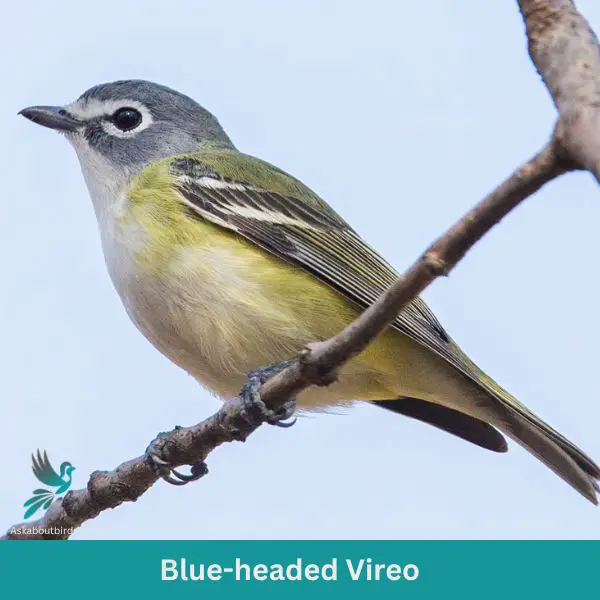
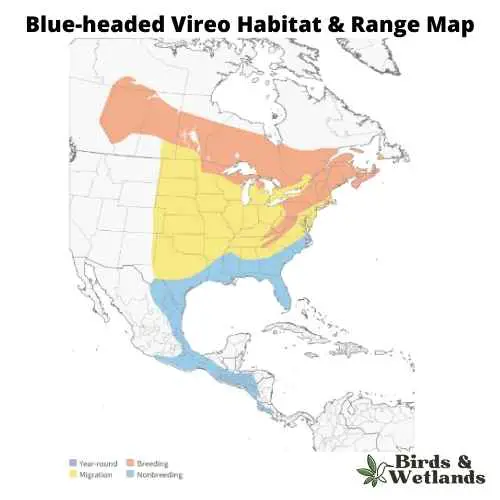
| Trait | Blue-headed Vireo |
|---|---|
| Scientific Name | Vireo solitarius |
| Length | 5-5.5 inches |
| Wingspan | 7.9-9.8 inches |
| Weight | 0.4-0.6 ounces |
The Blue-headed Vireo is a songbird recognized for its sharp and clear song as well as its distinct coloration.
Appearance: It has a blue-gray head and nape, contrasting sharply with its white throat and belly. A white eye ring combined with two white wing bars and yellowish flanks further accentuate its appearance.
Diet: The Blue-headed Vireo feeds mainly on insects and spiders. It often forages in the forest canopy, picking prey off leaves and twigs.
Reproduction: The female constructs a cup-shaped nest made of twigs, bark, and spiderwebs, often placed in the fork of a tree branch. Typically, she lays a clutch of 3-5 eggs. Both parents share the responsibility of incubating the eggs and feeding the chicks.
Cerulean Warbler
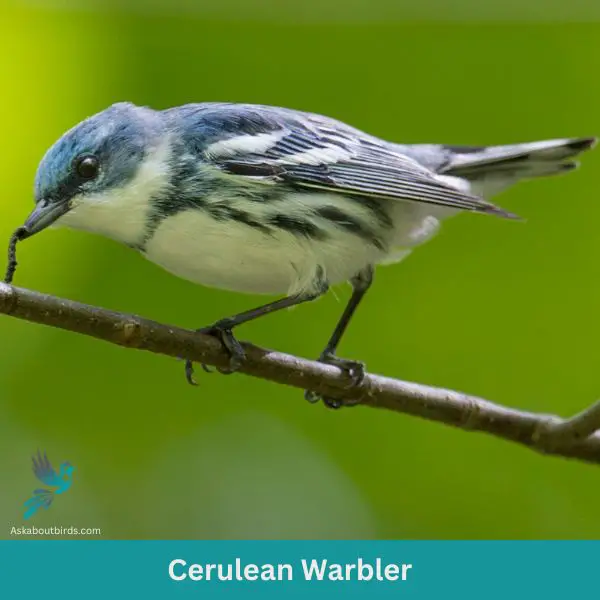
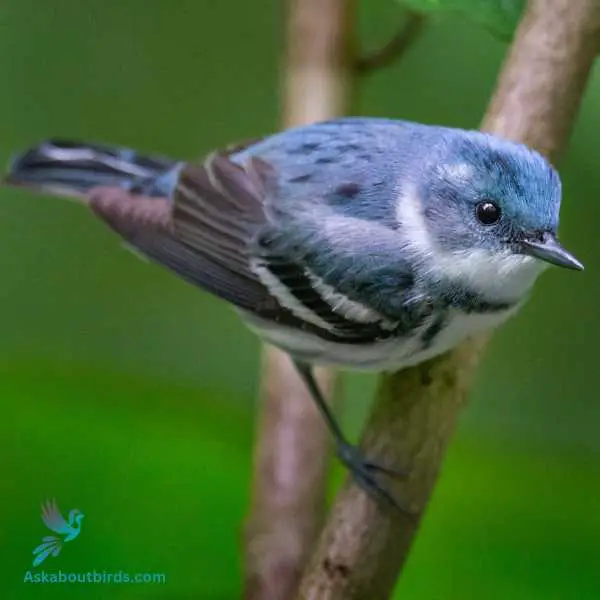
| Trait | Cerulean Warbler |
|---|---|
| Scientific Name | Setophaga cerulea |
| Length | 4.5 inches |
| Wingspan | 7.9-8.7 inches |
| Weight | 0.3-0.4 ounces |
The Cerulean Warbler is a striking songbird known for its sky-blue plumage and flitting movements in the forest canopy.
Appearance: Males boast a vibrant cerulean blue color on their upperparts, with streaked underparts, and a black necklace. Females have a more subdued bluish-green hue and lack the prominent black markings seen in males.
Diet: The diet of the Cerulean Warbler is predominantly made up of insects and spiders. They actively forage high in the treetops, gracefully maneuvering through leaves and branches.
Reproduction: Cerulean Warblers nest in the upper branches of tall deciduous trees. The female weaves a shallow cup-shaped nest and lays a clutch of 3-5 eggs.
Blue-winged Warbler
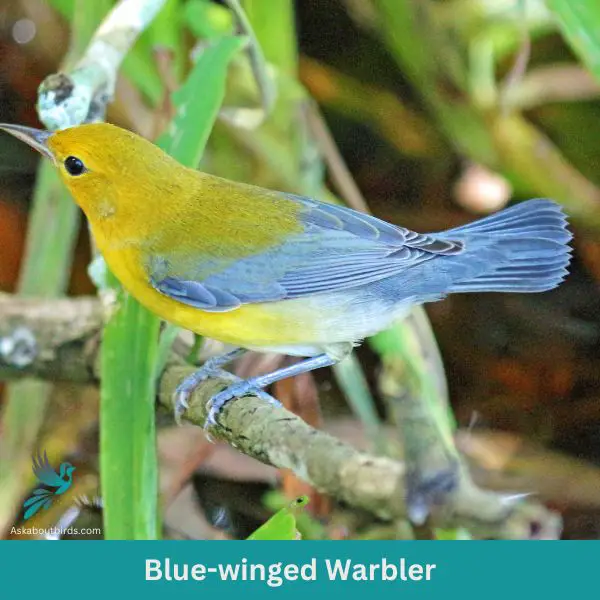
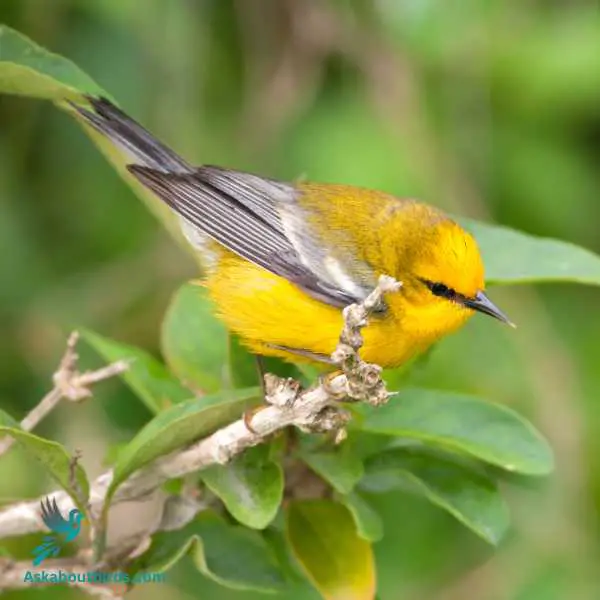
| Trait | Blue-winged Warbler |
|---|---|
| Scientific Name | Vermivora cyanoptera |
| Length | 4.3-4.7 inches |
| Wingspan | 6.7-7.5 inches |
| Weight | 0.3-0.4 ounces |
The Blue-winged Warbler is a vibrant songbird that stands out with its lemon-yellow coloring and buzzing song.
Appearance: This warbler displays a brilliant yellow body contrasted by blue-gray wings and a slim, black line through the eyes. The wings also feature two white wing bars.
Diet: The diet of the Blue-winged Warbler primarily consists of insects and spiders. They actively forage in shrubs and low trees, picking off their prey from the foliage.
Reproduction: Blue-winged Warblers build their nests on or near the ground, using grasses and other fine materials. The female lays a clutch of 4-6 eggs, which she incubates.
Where to Spot Pennsylvania’s Blue Birds
Pennsylvania is a haven for bird watchers, with its diverse landscapes offering a wide range of habitats for birds. Here are some of the top locations in Pennsylvania that are known for their great diversity of birds, including blue birds:
- Hawk Mountain Sanctuary: This is a prime location for raptor watching, but it also hosts a variety of other bird species. It’s a great spot to see the Eastern Bluebird and other native species.
- Presque Isle State Park: Located on Lake Erie, this park is a hotspot for migratory birds. Its varied habitats, from marshes to forests, attract a wide range of bird species, including the Blue Jay.
- John Heinz National Wildlife Refuge at Tinicum: This refuge is home to over 300 species of birds, making it one of the best bird-watching spots in the state. The Belted Kingfisher, a striking blue bird, is a common sight here.
- Middle Creek Wildlife Management Area: This area is known for its large populations of waterfowl, but it also hosts a variety of other bird species, including the Tree Swallow, which has a beautiful iridescent blue upper body.
- The Pocono Mountains: This region offers a range of habitats, from hardwood forests to wetlands, which attract a variety of bird species, including the Indigo Bunting, a small bird with brilliant blue plumage.
| State’s Blue Birds | Best Spots for Blue Birds |
|---|---|
| New York’s Blue Birds | 1. Central Park, New York City 2. Montezuma National Wildlife Refuge 3. Adirondack Park |
| New Jersey’s Blue Birds | 1. Cape May Point State Park 2. The Great Swamp National Wildlife Refuge 3. Island Beach State Park |
| Delaware’s Blue Birds | 1. Bombay Hook National Wildlife Refuge 2. Cape Henlopen State Park 3. Prime Hook National Wildlife Refuge |
| Maryland’s Blue Birds | 1. Blackwater National Wildlife Refuge 2. Assateague Island National Seashore 3. Patuxent Research Refuge |
| West Virginia’s Blue Birds | 1. Canaan Valley National Wildlife Refuge 2. New River Gorge National Park and Preserve 3. Beartown State Park |
| Ohio’s Blue Birds | 1. Magee Marsh Wildlife Area 2. Cuyahoga Valley National Park 3. Ottawa National Wildlife Refuge |
FAQs on Blue Bird Species Found in Pennsylvania
What are some characteristics of blue-gray gnatcatcher?
The blue-gray gnatcatcher is a small, migratory bird found in deciduous forests throughout the eastern half of the United States, Central and South America. It has a light gray plumage on its upper parts and white on its belly. Adult males develop a black cap on their heads during the breeding season. This bird is known for its high-pitched calls and its ability to catch insects in flight. Its scientific name is Polioptila caerulea.
What does a black-throated blue warbler look like?
The black-throated blue warbler is a medium-sized bird with distinct sexual dimorphism. Adult males have a vibrant blue plumage on their upper parts, a black throat and face, and a white belly. Females have a more subdued brown plumage with a light gray or white eyebrow and a white belly. This species is mostly found in deciduous forests in the eastern United States during the breeding season and migrates to Central and South America for the winter. Its scientific name is Setophaga caerulescens.
How can you identify a great blue heron?
The great blue heron is a large wading bird with a long neck and legs, and a sharp bill used to catch fish and other aquatic prey. Its plumage is mostly blue-gray with a white head and a black stripe above its eye. It has a white belly and chest with black stripes. Great blue herons are found in both fresh and saltwater habitats across North America. They often stand motionless in shallow water, waiting to strike at prey. Its scientific name is Ardea herodias.
Which bird species have bright blue feathers?
Several bird species have bright blue feathers. The Eastern Bluebird (Sialia sialis) has a vibrant blue plumage on its back, head, and wings, with a rusty chest and white belly. The Indigo Bunting (Passerina cyanea) is another bird with a rich blue range; adult males have a brilliant, almost royal blue plumage all over. The Black-throated Blue Warbler (Setophaga caerulescens) also has a striking blue coloration, particularly in males, which have a dark blue back and head, black throat, and white belly.

